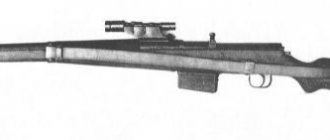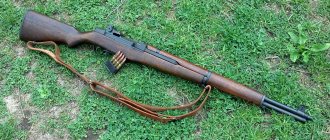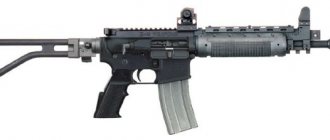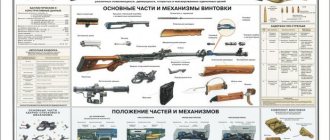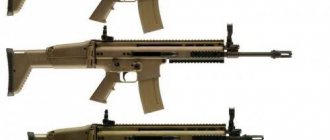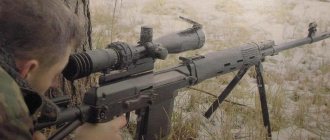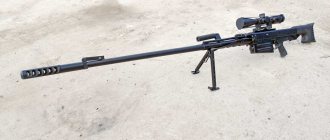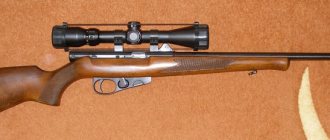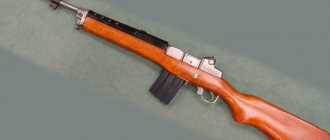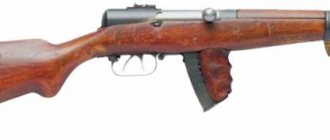Among the variety of small arms that were used by Soviet troops in World War II, not a single type of weapon received such controversial assessments as the SVT-40 automatic rifle. Most experts have a not very flattering opinion about this weapon. It is believed that this rifle was unsuccessful, which is why it was discontinued.
The release of SVT-40 occurred during wartime, when product quality receded into the background, and quantity and manufacturability of production became the main thing. Perhaps, if not for the war, this weapon could have been improved and its shortcomings eliminated. In addition, not everyone who has had the opportunity to use this weapon speaks negatively about it.
The cause of the problems of this type of weapon is the overly powerful rifle cartridge, which is what led to the excessive weight of the weapon.
It should also be noted that the Tokarev self-loading rifle was a desired trophy for our opponents, the Germans and Finns, and they were well versed in small arms. Only two countries in the world entered the war armed with a serial self-loading rifle - the USA and the USSR. For the Americans it was the M1 Garand, and for the Soviet Union it was the Tokarev rifle. Moreover, in the USSR they made a serial automatic rifle earlier than in America.
A little history
The idea of turning conventional weapons into automatic weapons has been in the air since the creation of the unitary cartridge, but work in this direction became especially intensified at the end of the 19th century. However, things did not go further than experimental samples. Similar studies were carried out in the Russian Empire. Fedor Vasilyevich Tokarev, a native of the Don province, was one of the most active enthusiasts working in this direction in Russia.
While still a student at the Officer Rifle School, he proposed a project for a self-loading repeating rifle - but it never went into production. In Russia, several other designers were engaged in similar developments, but they did it solely on their own initiative.
They wanted to put an automatic rifle into service in Russia in 1910, then the deadline was postponed to 1915, but the war began, and this project had to be forgotten for many years. In 1916, the Fedorov automatic rifle was adopted by the Russian army and took part in hostilities. Then there was a revolution, a civil war, difficult times of devastation. Active development continued only in the 30s.
In 1936, the ABC-36, a Simonov automatic rifle, was put into service, which, however, had a large number of shortcomings and shortcomings. Therefore, a new competition was announced, the projects of Simonov, Tokarev and Rukavishnikov took part in it. The Tokarev rifle won the competition, after which it was adopted by the Red Army.
SVT-38, compared to its competitors, was more compact and easier to manufacture. The Tokarev self-loading rifle of the 1938 model began to be produced at the Tula Arms Plant. However, already in 1939, a government commission was organized that was involved in improving the SVT-38. The designer was tasked with bringing the characteristics of his weapon closer to the ABC-36.
In 1940, SVT-38 went through the harsh school of the Finnish war. The use of weapons in real combat operations and in difficult conditions made it possible to identify the shortcomings of the SVT-38. The main ones were the heavy weight of the weapon, its capriciousness, sensitivity to dirt and low temperatures, and requirement for lubrication.
The designer was required to reduce the weight and dimensions of the weapon (the weight should be no more than that of the Mosin rifle), but at the same time it was necessary to make the SVT more reliable and unpretentious.
Designers could not reduce the size of parts, because in this case the operation of the automation would be disrupted. They had to lighten the existing elements of the weapon as much as possible, make them thinner, and increase tolerances. It was necessary to reduce the length of the bayonet, remove the cleaning rod under the barrel, and make changes to the rifle magazine, to the forend, and to the barrel lining casing. There is information that Stalin himself took care of the length of the bayonet, who kept the development of a self-loading rifle under personal control. He ordered her maximum bayonet. The modified rifle became easier to manufacture than its SVT-38 counterpart, but the main problems associated with the heavy weight and complexity of the device could not be solved.
In 1940, a new Tokarev self-loading rifle was put into service under the name SVT-40. The designers managed to fulfill all the wishes of the customers. They achieved the required weight, but it came at a high price. SVT-40 was designed to the limit of technical capabilities; its elements were very sensitive to production accuracy and compliance with technological rules. In wartime conditions and the decline in worker qualifications, the quality of weapons often suffered. The rifle required competent maintenance and careful care. It was difficult to demand this from poorly trained fighters, most of whom were drafted from rural areas.
With the beginning of the war, the production of SVT-40 increased significantly: in 1941 alone, more than a million copies of this weapon were manufactured. In 1940, the production of sniper rifles based on this rifle also began; a new optical sight was developed for it; it was planned to make the main sniper rifle of the Red Army from the SVT-40. However, the new sniper rifle had much lower accuracy than the Mosin rifle of the 1891/30 model. To increase shooting accuracy, the design of the weapon had to be changed, so this idea was abandoned and production of the old-style sniper rifle was resumed.
In 1942, the SVT automatic rifle appeared, which could fire automatically. However, the Tokarev rifle was not originally intended for automatic fire.
Tokarev also worked on the creation of a self-loading carbine. The first samples created on the basis of the SVT-38 appeared already in 1940. However, this carbine was considered unsatisfactory. Later, he designed a carbine based on the SVT-40, but it also did not pass the tests. Subsequently, carbines based on the SVT-40 were produced in small batches, and there is information that they were sent to the troops. There is no data on their combat use.
SVT-40 rifles did not gain much popularity. Their production gradually began to wind down due to the complexity of these weapons. In terms of labor intensity, the SVT-40 was almost twice as much as the Mosin rifle. In addition, design flaws could not be completely eliminated, although the developers made efforts to do so. The Tokarev self-loading rifle required careful care and proper handling. It was almost impossible to ensure this in conditions of mass conscription and low technical literacy of conscripts.
Weapon device
The rifle's automatic operation is based on the use of powder gases, which are removed from the barrel and push a short-stroke gas piston. The gas chamber is equipped with a regulator that can regulate the amount of gases released. This allows you to adapt the weapon to environmental conditions, the type of ammunition, and the condition of the rifle.
The gas piston moves backward and transmits impulse to the bolt. The return spring sends it back. The barrel bore is locked by tilting the bolt. The bolt device includes a firing pin and a cartridge ejection mechanism. The receiver also contains a return spring, which returns the bolt frame and bolt back.
The hammer-type impact mechanism, the safety locks the trigger.
The SVT-40 rifle magazine is box-shaped, double-row, with a capacity of ten rounds. You can load the SVT-40 without removing the magazine using two standard clips from a Mosin rifle. After the ammunition is used up, the bolt is locked in the rear position.
Sights consist of a front sight, which is installed in the muzzle, and a rear sight, which can be adjusted in range.
The rifle stock is wooden, solid. The top of the barrel and gas piston are covered with a metal casing. There is also a wooden fore-end into which a cleaning rod is inserted. There is a muzzle brake.
The rifle is equipped with a bayonet. According to the regulations, it was to be carried in a sheath and attached to the rifle only when necessary. The SVT-40 bayonet is shorter than that of the SVT-38.
Application
It was originally planned that the SVT-40 self-loading rifle would become the main weapon of Soviet infantrymen and significantly increase the firepower of the units. According to the staff, a Soviet rifle division should have had several thousand units of such weapons. The ratio of self-loading and non-automatic rifles was assumed to be approximately 1:2. But everything happened differently.
By June 1941, about a million SVT-40 rifles were manufactured, most of them were in service with the western border districts.
Soviet rifles were not inferior to the American M1 Garand rifle, they earned high praise from the enemy.
The Germans enjoyed using captured SVT-40 rifles (and even adopted them); at the beginning of the war they did not have such weapons. For example, due to the firing range of the SVT during the defense of the Brest Fortress, the Germans could not get within effective range of their submachine guns.
In the middle of the war, the Germans developed their own self-loading rifle, the 7.92 mm G.43, many of the components and elements of which were strongly reminiscent of the SVT-40.
However, in the Soviet Union itself, the production of these weapons was gradually curtailed. The reason for this was quite simple: the rifle was difficult to manufacture and required a lot of resources and skilled labor. SVT-38 consisted of 143 parts, 22 of which were springs. For its manufacture, several types of steel (including special ones) were needed. The cost of this weapon was higher than that of the Degtyarev machine gun.
The Mosin rifle was much faster and cheaper to make. In addition, it corresponded to the level of training of the personnel. The issue of mass automatic weapons was resolved by the active production of submachine guns - weapons that were much cheaper and easier to produce.
The problem of the complexity of manufacturing the SVT-40 became especially acute in the first months of the war after the evacuation of many defense enterprises and the departure of a large number of qualified workers to the front.
The attitude of the soldiers towards the rifle was very contradictory: on the one hand, the SVT-40 was quite capricious, requiring increased attention and careful care (for this it was called “Svetka”, hinting at a woman’s capricious character), but on the other hand, it had an excellent rate of fire and a high combat power. With proper care, this weapon did not create any special problems and served its owner faithfully.
The most complaints about the capricious nature of the rifle came from soldiers of rifle units with a low level of training. The Marines and paratroopers were quite pleased with these weapons.
After the catastrophic defeats of the initial period of the war, a lot of recruits were called to the front, most of whom did not know the structure of this weapon and had no idea how to take care of this rifle. At the front, the lubricant needed for these weapons was often lacking. Most of the gunpowder that was used by the Red Army in the final stages of the war came to the USSR under Lend-Lease. This gunpowder contained additives that caused increased carbon formation, so the rifle had to be cleaned frequently.
After the invention of the intermediate cartridge by the Germans and their development of weapons for it, many experts and designers began to be inclined to think that the time of automatic systems for the rifle cartridge was in the past. This type of ammunition led to excessive weight of the weapon and the ammunition carried, and the power of such a cartridge was clearly excessive. It was the intermediate cartridge that made it possible to solve the main problems associated with automatic rifles.
Usage history
In the early 1940s, the self-loading rifle was to become the main personal weapon of the Soviet infantry. Thus, in the rifle division of the Red Army, according to state No. 04/400-416 of April 5, 1941, it was supposed to have 3307 self-loading rifles and 6992 non-automatic rifles and carbines, while in a rifle company - 96 and 27, respectively, and in a rifle department - only self-loading rifles (8 pieces).
According to pre-war plans, it was planned to produce 1.8 million SVTs in 1941, and 2 million in 1942. By the beginning of the war, over 1 million SVTs had been produced, and many first-line units and formations, mainly in the western military districts, received a standard number of self-loading rifles . In 1942, their production, however, amounted to only 264 thousand (and 14.2 thousand sniper rifles). Production was discontinued by order of the State Defense Committee in 1945.
Soviet self-loading rifles, not inferior to the American M1 Garand and clearly superior to the later German G.41(M) and G.41(W), earned fairly high praise from foreign experts. The significant number of automatic rifles carried by Soviet riflemen came as a surprise to the Germans at the beginning of the war (a German soldier wrote home in the summer of 1941: “The Russians are completely armed with light machine guns”). During the siege of the Brest Fortress, German infantry could not get within range of their submachine guns until the defenders ran out of ammunition. The commander of the 2nd Panzer Army G. Guderian in a report on the experience of combat operations on the Eastern Front dated November 7, 1941 about
Along with other captured SVT models, they were adopted by the Wehrmacht. The SVT-40, which fell into the hands of the Finns, became the basis for the TaRaKo rifle (which, however, did not go into production). In the Red Army, however, their rearmament during the war was curtailed for completely objective reasons. The main one was the low-tech production: as noted by the People's Commissar of Armaments D.F. Ustinov, the SVT-38 consisted of 143 parts (of which 22 were springs), the production of which required 12 grades of steel (including two special ones). This explains the high cost of the SVT (higher than the DP light machine gun and an order of magnitude more than the model 1891/30 rifle).
In the context of the military defeats of 1941-1942, the evacuation of industry, the lack of qualified personnel and the growing needs of the front for weapons, this was completely unacceptable, and its production had to be abandoned in favor of much simpler and cheaper models - repeating rifles and submachine guns. In addition, like any automatic weapon, the SVT required more careful care and handling than a conventional rifle (therefore, the SVT remained in service longer with naval units, where more technically competent soldiers were recruited).
It was difficult to quickly teach these skills to a huge number of wartime conscripts, who often had never dealt with complex equipment. In peaceful pre-war times, inspections often found cases in the troops that not only ordinary soldiers, but also commanders did not know the structure of a self-loading rifle well, sometimes they did not even know how to disassemble and clean it. Most of the SVT available in the troops were lost in 1941-1942 . Thus, this rifle did not play a significant role during the hostilities.
A similar situation arose in most other countries participating in the war, with the exception of the United States, where back in 1939 the self-loading Garand rifle was adopted as the main weapon of the infantry, with which almost all units participating in the hostilities were armed, and, partly, Germany, where Attention was focused on the development of “Sturmgewehrs” - a new class of weapons chambered for an intermediate cartridge.
By the end of World War II, the prevailing opinion in the USSR was that the automatic rifle chambered for a standard rifle cartridge as the main weapon of an infantryman had outlived its usefulness, and the introduction of weapons chambered for an intermediate cartridge began.
At the same time, in the USA and in the West in general, for a long time after the end of World War II (until the mid-1960s and the adoption by NATO of the 5.56-mm low-pulse intermediate cartridge), the concept of precision self-loading and automatic weapons under a powerful rifle cartridge, similar to the Soviet pre-war ones, prevailed. ABC and SVT, examples of which include M14, BM 59, G3, FN FAL, L1A1 and other samples. A significant part of them are still in service, although in secondary roles. Moreover, new models of this class are being created - for example, the FN SCAR H automatic rifle, intended for USSOCOM special forces.
Weapon modifications
- Self-loading rifle (SVT-38). The weight of the self-loading rifle, including the magazine and bayonet, is 4.9 kg, which is 0.6 kg more than the weight of the 1940 model rifle. It has a heavier bayonet, a different stock shape, and differs in a number of other small details.
- Self-loading rifle (SVT-40). An improved modification with a shortened bayonet, it was put into service at the beginning of 1940. The weight of the rifle has been reduced by 600 grams, the manufacturability and reliability have been slightly increased.
- Sniper rifle (SVT-40). This modification was put into service in 1940. The rifle has a bracket for mounting an optical sight and higher quality barrel processing.
- Automatic rifle (AVT-40). The rifle, with minor changes in the trigger mechanism, is very similar in appearance to the base model. It was not particularly widespread and was withdrawn from production and service in 1942. The reason was that the SVT-40 was poorly suited for automatic fire. It was allowed to be carried out only in extreme cases.
- Automatic carbine (AKT-40). This weapon can fire automatically.
- Hunting carbine (OSK-88). Hunting rifled weapons intended for civilian use.
- SVT-O. A hunting rifle, it was presented to the general public in 2012. These carbines were converted from AVT-40 rifles, decommissioned from the mobilization reserve. This weapon can only fire single fire.
Types of modifications
- The SVT-38 was produced before 1940 and is characterized by a mass that is 500 grams greater than the next model. Its bayonet has not yet undergone lightening changes; the stock has the originally created shape.
- The SVT-40 is already an improved type with a shortened shield, and begins mass production in 1940. It is distinguished by increased reliability, lighter than the previous version by 600 grams.
- The SVT-40 sniper rifle, the characteristics of which allow for targeted fire, was put into production in 1940. It is distinguished by the presence of a special stop for installing an aiming device and more advanced processing of the barrel surface.
- The AVT-40 is an automatic variant with minor improvements to the trigger mechanism; the appearance is reminiscent of the basic SVT-38 model. Despite the efforts of the designers, it was not possible to create a reliable automatic rifle, and the production of such weapons was curtailed in 1942.
- The AKT-40 is an automatic carbine that is not used in the army, although it is intended for targeted automatic fire.
- The SVT-O is a hunting type weapon, converted from the SVT-40 weapon, which was withdrawn from the army mobilization reserve. Today the product is presented in the form of a weapon for single shooting. Available to the general public since 2012.
In conclusion, it should be noted that for the production and improvement of the design of the rifle, not very successful war years are chosen; bets are placed on the quantity of weapons, and not on their quality. If this had happened in peacetime, then better shooting weapons would have been produced based on the rifle.
Specifications
| Caliber | 7.62 mm |
| Length: | |
| with a bayonet | 1583 mm |
| without bayonet | 1226 mm |
| Barrel length | 635 mm |
| Weight: | |
| with a bayonet | 4.55 kg |
| without bayonet | 4.15 kg |
| Magazine capacity, pcs. | 10 |
| Sighting range | 1500 m |
SVT-40
| Caliber | 7.62 mm |
| Length: | |
| with a bayonet | 1470 mm |
| without bayonet | 1226 mm |
| Barrel length | 625 mm |
| Weight: | |
| with a bayonet | 4.13 kg |
| without bayonet | 3.85 kg |
| Magazine capacity, pcs. | 10 |
| Sighting range | 1500 |
Photo OSK-88
OSK-88 (SVT-40) 1940 according to the 1989 passport.
Similar
AK-47 assault rifle cartridge caliber 7.62 mm.
Device. Rate of fire AK-74 assault rifle cartridge 5.45 mm caliber. Device. Rate of fire
Dragunov SVD sniper rifle caliber 7.62 mm. Device
AKS-74U assault rifle cartridge caliber 5.45 mm. Device. Weight
Mauser K96 pistol cartridge caliber 7.63 and 9 mm. Device
Pistol Walter PP / PPK cartridge caliber 7.65 and 9 mm. Device
Pistol Yarygin PYa Grach cartridge caliber 9 mm. Device
DShK machine gun cartridge caliber 12.7 mm. Device. Rate of fire
Luger pistol R.08 Parabellum cartridge caliber 9 mm. Device
Pistol PM cartridge caliber 9 mm. Rate of fire. Dimensions. Bullet speed. Sighting range
Self-loading shotgun Saiga-12 cartridge, caliber. Device
Maxim machine gun cartridge caliber 7.62 mm. Device. Weight
PPSh-41 Shpagina submachine gun cartridge caliber 7.62 mm
APS Stechkin pistol cartridge caliber 9 mm. Device
Nagan system revolver cartridge caliber 7.62 mm. Device
Kalashnikov PK machine gun and PKM cartridge caliber 7.62 mm. Device
Simonov carbine SKS-45 cartridge caliber 7.62 mm. Device
Rifles and carbines Mauser 98 caliber 7.92 mm. Device
PPS-42 and PPS-43 Sudaev submachine gun cartridge caliber 7.62 mm
Pistol Walter P38 cartridge caliber 9 mm. Device
MP-40 German submachine gun cartridge caliber 9 mm. Device
VSS Vintorez sniper rifle caliber 9 mm. Device
Submachine gun PP-91 Kedr cartridge 9 mm caliber. Device
Light machine gun RPK-74 cartridge caliber 5.45 mm. Device
Pistol Glock 17 cartridge caliber 9 mm. Device
Makarych, Izh-79-9T, MR-79-9TM, MP-80-13T traumatic pistol
AK-12 assault rifle cartridge caliber 5.45 mm. Device. Weight
Mosin rifles and carbines Three-line caliber 7.62 mm
PMM Makarov pistol modernized 12 rounds. Device
Revolver Colt Single Action Army (SAA) Peacemaker. Device
Machine gun PKP Pecheneg cartridge caliber 7.62 mm. Device
Sniper rifle VSSK Exhaust caliber 12.7 mm. Device
Beretta pistol 92 cartridge caliber 9 mm. Device
TT - Tokarev pistol cartridge caliber 7.62 mm. Device
Submachine gun PP-19 Bison cartridge caliber 9 and 7.62 mm. Device
Sniper rifle SV-98 caliber 7.62 mm. Device
Vladimirov KPV machine gun cartridge caliber 14.5 mm. Device
ASH-12 assault rifle cartridge caliber 12.7 mm. Device. Rate of fire
PSM pistol cartridge caliber 5.45 mm. Device
Pistol Colt M1911A1 cartridge caliber 45. Device
Smith-Wesson revolver Russian cartridge, caliber 10.67 mm. Device
Degtyarev DP-27 light machine gun, 7.62 mm caliber cartridge. Device
Shotgun Mossberg 500 Cartridge. Dimensions. Rate of fire. Sighting range
Thompson submachine gun cartridge caliber 11.43 mm. Device
Pistol USP Heckler und Koch cartridge, caliber. Device
Hunting carbine OSK-88 (SVT-40) caliber 7.62 mm. Device
AS Val silent automatic cartridge caliber 9 mm. Device
Submachine gun PP-19-01 Vityaz cartridge 9 mm caliber. Device
Machine gun Kord cartridge caliber 12.7 mm. Device. Weight. Sighting range
Osa - traumatic pistol cartridge, caliber. Device
AK-9 assault rifle cartridge caliber 9 mm. Device. Rate of fire
Degtyarev RPD light machine gun, 7.62 mm caliber cartridge. Device
Automatic OTs-14 Groza cartridge caliber 9 mm and 7.62 mm. Device
Czech pistol CZ-75 (modifications). Device
Browning pistol 1903 cartridge caliber 9 mm. Device
Sniper rifle OSV-96 caliber 12.7 mm. Device
FN P90 submachine gun cartridge caliber 5.7 mm. Device
Submachine gun OTs-02 Cypress cartridge caliber 9 mm. Device
Sniper rifle ASVK Kord caliber 12.7 mm. Device
Automatic AEK-971 Cartridge. Caliber. Device. Rate of fire
Steyr AUG assault rifle (A1, A2, A3) cartridge caliber 5.56 mm
AK series 100 assault rifles. Modifications. Device. Weight. Dimensions
Uzi submachine gun. Cartridge. Caliber. Rate of fire
Pistol SR1M Gyurza cartridge caliber 9 mm. Device
Pistol GSh-18 cartridge caliber 9 mm. Device
SVDK sniper rifle caliber 9.3 mm. Device
Automatic SR-3M Whirlwind cartridge caliber 9 mm. Device
Machine gun NSV-12.7 Utes cartridge, cal. Device. Weight
Kalashnikov RPK light machine gun cartridge caliber 7.62 mm. Device
Sniper rifle VSK-94 caliber 9 mm. Device
Vostok-1 (Jorge-3M) 9mm caliber traumatic pistol. Device
Degtyarev PPD submachine gun cartridge caliber 7.62 mm
English sniper rifle L96A1 cartridge, caliber
M1 Garand rifle cartridge caliber 7.62 mm. Device
Desert Eagle pistol. Device
Smith-Wesson revolver (modifications). Device
Automatic rifle HK G36 (E, K, C, KE) cartridge caliber 5.56 mm
Pistol P-96 cartridge caliber 9 mm. Device. Rate of fire
Pistol GP35 Browning High Power cartridge, caliber. Device
Assault rifle FN SCAR (L, H) cartridge caliber 5.56 and 7.62 mm
Revolver Lefoshe M1856 cartridge caliber 11 mm. Device
Submachine gun PP-90 cartridge caliber 9 mm. Device
AN-94 Abakan automatic Nikonov cartridge caliber 5.45 mm. Device
Submachine gun PP-2000 cartridge caliber 9 mm. Device
Mauser pistol HSc cartridge caliber 7.65 and 9 mm. Device
M16 automatic rifle cartridge caliber 5.56 mm. Device
Fedorov assault rifle cartridge caliber 6.5 mm. Device. Rate of fire
Pistol Baltiets cartridge caliber 7.62 mm. Device
Strizh pistol cartridge caliber 9 mm. Device. Weight. Sighting range
Browning pistol 1910 cartridge caliber 7.65 and 9 mm
Silent pistol PSS Vul cartridge caliber 7.62 mm. Device
Pistol SIG-Sauer P226 cartridge caliber 9 mm. Device
Pistol OTs-27 Berdysh cartridge caliber 7.62 mm and 9 mm. Device
AK-107 assault rifle cartridge caliber 5.45 mm. Device. Rate of fire
OTs-44 sniper rifle, caliber 12.7 mm. Device
German machine gun MG3 cartridge caliber 7.62 mm. Device
Self-loading shotgun Browning Auto-5 cartridge, caliber. Device
Submachine gun AEK-919K Kashtan cartridge caliber 9 mm. Device
PB pistol silent cartridge 9 mm caliber. Device
Pistol OTs-33 Pernach cartridge caliber 9 mm. Device
Hunting carbine KO-98 cartridge caliber 7.92 mm. Device
TK (Korovin pistol) caliber 6.35 mm. Device. Weight. Dimensions
Underwater assault rifle APS cartridge caliber 5.66 mm. Device
Pistol OTs-21 Malysh cartridge caliber 9 mm. Device
American M60 machine gun, 7.62 mm caliber cartridge. Device
MTs-116M sniper rifle, caliber 7.62 mm. Device
Automatic 9A-91 cartridge caliber 9 mm. Device. Rate of fire
Submachine gun PP-93 cartridge caliber 9 mm. Device
VAG-73 - Gerasimenko pistol. Device. Weight. Dimensions
Cordon-5 is a traumatic pistol. Device. Weight. Dimensions
Goryunov SG-43 heavy machine gun cartridge caliber 7.62 mm. Device
Webley revolver cartridge, caliber. Device. Dimensions. Weight
Machine gun AEK-999 Badger cartridge caliber 7.62 mm. Device
RP-46 machine gun, 7.62 mm caliber cartridge. Device. Rate of fire
Sniper rifle VS-8 cartridge caliber 8.6 mm. Device
Slostin machine gun cartridge caliber 7.62 mm and 14.5 mm. Device
Assault rifle Tavor TAR-21 cartridge caliber 5.56 and 5.45 mm
Submachine gun SR-2 Veresk cartridge caliber 9 mm. Device
Lancaster pistol cartridge caliber 12.1 mm. Device. Rate of fire
Submachine gun PP-90M1 cartridge caliber 9 mm. Device
Underwater pistol SPP-1M. Device. Weight. Dimensions
Traumatic pistol MP-461 Guard. Device. Weight. Dimensions
Lebel rifles and carbines are cartridgeed in 8 mm caliber. Device
Automatic A-91 cartridge caliber 7.62 mm. Device. Rate of fire
M14 automatic rifle cartridge caliber 7.62 mm. Device
Revolver Smith & Wesson Model 10 Military & Police
Automatic rifle FN FAL cartridge caliber 7.62 mm. Device
Submachine gun STEN MK 2. Device. Weight. Dimensions
Traumatic pistol IZH-78-9T Chain mail cartridge caliber 9 mm
Leader-M traumatic pistol 11.43×32T. Device. Weight. Dimensions
Ingram M10 and M11 submachine gun. Device. Weight. Dimensions
Pistol Steyr M9-A1 cartridge caliber 9 mm. Device. Weight
Pistol OTs-23 Dart cartridge caliber 5.45 mm. Device
Berthier rifles and carbines caliber 8 mm. Device
Automatic shotgun USAS-12 cartridge caliber 18.5 mm
Sniper rifle VS-121 caliber 7.62 mm. Device
Traumatic pistol MP-353 cartridge, caliber 11.43 mm
Tiss machine gun cartridge caliber 9 mm. Device. Rate of fire
Traumatic pistol MP-355 cartridge caliber 9 mm. Device
Automatic double-medium ADS cartridge caliber 5.45 mm. Device. Rate of fire
Traumatic pistol MP-81 cartridge caliber 9 mm. Device
Pistols Zastava 70 and 70(k), cartridge caliber 7.65 or 9 mm. Yugoslavia
Sniper rifle GALATZ (Galil) cartridge caliber 7.62 mm
Pistol MP-444 Bagheera cartridge caliber 9 mm. Device
Revolver Colt New Army / Navy. Device. Bullet speed. Sighting range
Type 64 is a Japanese automatic rifle. Device
